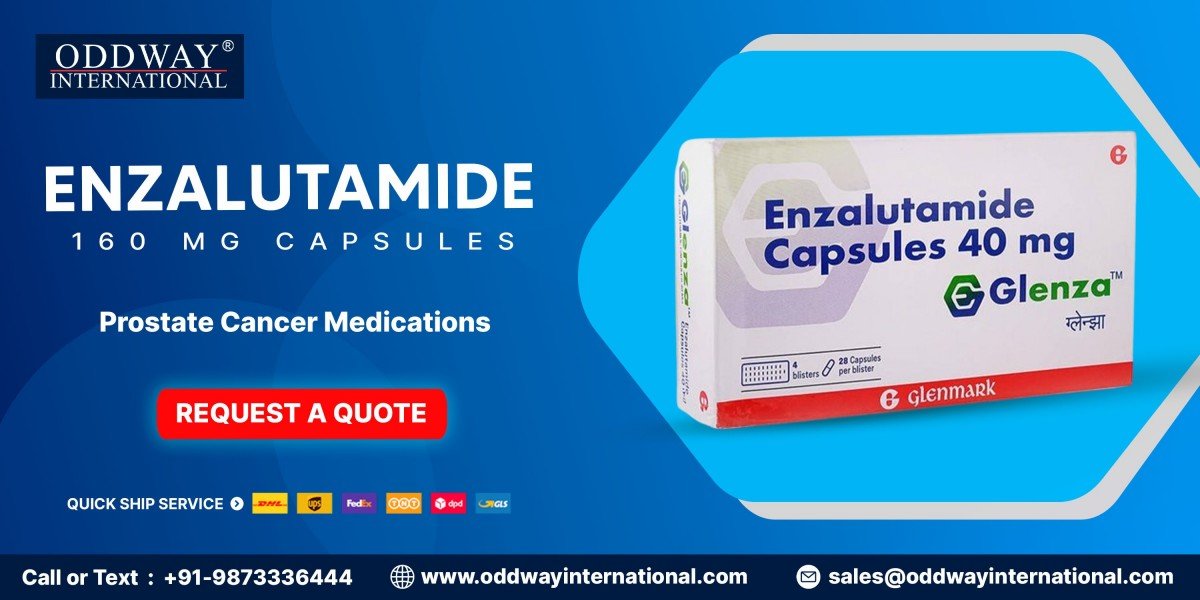Enzalutamide (brand name: Xtandi) is a powerful androgen receptor inhibitor used primarily in the treatment of prostate cancer. Approved by the FDA for metastatic castration-resistant prostate cancer (mCRPC), it has become an essential tool in managing advanced prostate cancer by targeting the androgen receptor, which plays a key role in tumor growth. Enzalutamide works by blocking the effects of androgens (male hormones like testosterone), which are known to fuel the growth of prostate cancer cells.
For patients with prostate cancer, treatment can often be multifaceted, involving a combination of therapies. This approach aims to improve treatment efficacy, reduce resistance to therapies, and enhance overall survival. But can enzalutamide capsules 40 mg be safely used in combination with other therapies?
Understanding Enzalutamide: How It Works
Enzalutamide is a non-steroidal anti-androgen that binds to androgen receptors, preventing the activation of these receptors by androgens. This inhibition reduces the ability of prostate cancer cells to grow and proliferate, particularly in cases of castration-resistant prostate cancer (CRPC), where tumors continue to grow despite low levels of testosterone.
In addition to blocking androgen binding, enzalutamide also:
Prevents nuclear translocation: The drug inhibits the movement of the androgen receptor into the cell nucleus, which is necessary for the receptor to trigger gene expression associated with tumor growth.
Interferes with androgen receptor binding: Enzalutamide prevents the androgen receptor from binding to DNA, further inhibiting the cell’s ability to replicate and survive.
Decreases androgen receptor activity: Enzalutamide can also affect the overall functionality of the androgen receptor, making it less responsive to stimulation.
Enzalutamide as Monotherapy
Enzalutamide has demonstrated significant efficacy as a monotherapy for metastatic castration-resistant prostate cancer (mCRPC). In clinical trials, it has been shown to extend overall survival, delay disease progression, and reduce pain associated with the disease.
For patients with advanced prostate cancer, enzalutamide is typically prescribed after other forms of treatment, such as surgery or radiation, have been exhausted. Studies like the AFFIRM trial have established the drug’s effectiveness in extending survival by months, highlighting its potential as a cornerstone of prostate cancer treatment in this advanced stage.
While enzalutamide is available in several formulations, enzalutamide capsules 40 mg is the most common prescription, providing an effective dose to manage the disease. Some patients may also be prescribed higher doses, such as the enzalutamide 40 mg price formulation, depending on their individual needs and the doctor’s recommendations.
The Role of Combination Therapy in Prostate Cancer
Although enzalutamide is highly effective, it is not a cure for advanced prostate cancer, and patients may eventually develop resistance to the drug. This is where combination therapy comes into play. Using enzalutamide in combination with other therapies has the potential to overcome resistance mechanisms, enhance treatment efficacy, and provide a more comprehensive approach to managing the disease.
Combination therapy in prostate cancer can involve:
Chemotherapy: Using chemotherapy alongside enzalutamide can target rapidly dividing cancer cells while enzalutamide works to inhibit the androgen receptor signaling pathway.
Immunotherapy: Combining enzalutamide with immunotherapies like immune checkpoint inhibitors may help activate the body's immune system to recognize and attack prostate cancer cells.
Radionuclide therapy: Agents like radium-223 can be combined with enzalutamide to deliver targeted radiation therapy to cancer cells in the bones.
Other hormonal therapies: Drugs that target different pathways involved in androgen signaling, such as abiraterone acetate or enzalutamide, can be used together to enhance the anti-cancer effects.
Targeted therapies: Drugs that target specific molecules involved in cancer cell growth, such as PARP inhibitors, can potentially be used with enzalutamide to increase therapeutic efficacy.
The idea behind combination therapy is to take advantage of different mechanisms of action, thereby attacking the cancer from multiple angles and improving outcomes for patients.
Combination with Chemotherapy
One of the most commonly studied combinations with enzalutamide is chemotherapy, particularly with drugs like docetaxel. In clinical trials, combining enzalutamide with docetaxel has been shown to improve survival outcomes in patients with metastatic prostate cancer. The combination takes advantage of the synergistic effects of chemotherapy and the androgen receptor inhibition provided by enzalutamide.
For example, in the PREVAIL trial, which studied the use of enzalutamide with docetaxel, researchers found that the combination therapy provided a significant survival benefit when compared to either treatment alone. Docetaxel works by inhibiting cancer cell division, while enzalutamide limits androgen-driven cancer cell growth, providing a more comprehensive approach to cancer management.
This combination therapy is particularly beneficial for patients who have become resistant to other therapies, as chemotherapy can help target cancer cells that have developed resistance mechanisms to androgen deprivation therapy (ADT) alone.
Combination with Immunotherapy
While prostate cancer has traditionally been less responsive to immunotherapy than other cancers (like melanoma or lung cancer), the use of immunotherapy agents like checkpoint inhibitors in combination with enzalutamide is an area of active research.
One promising approach is the combination of enzalutamide with PD-1/PD-L1 inhibitors, which are designed to unblock immune checkpoints, allowing the body’s immune system to recognize and fight cancer cells more effectively. By combining enzalutamide with immunotherapy, researchers aim to increase the body’s immune response while inhibiting the androgen signaling pathways that drive cancer growth.
However, this approach is still in early stages, and more clinical trials are needed to confirm the safety and efficacy of these combinations.
Combination with Radionuclide Therapy
Another potential combination is the use of enzalutamide alongside radionuclide therapies like radium-223 or lutetium-177. These therapies are designed to deliver targeted radiation directly to cancer cells, especially those that have spread to the bones. Combining enzalutamide with radionuclide therapy can provide a dual approach: while enzalutamide inhibits androgen receptor signaling to prevent tumor growth, radionuclide therapy can directly damage cancer cells with radiation.
The combination of enzalutamide and radium-223 has shown promise in treating patients with prostate cancer that has spread to the bones, offering a treatment that not only targets the androgen receptor but also delivers localized radiation therapy to bone metastases.
Combination with Other Hormonal Therapies
Another important area of research is combining enzalutamide with other hormonal therapies, such as abiraterone acetate (which inhibits CYP17, a critical enzyme in androgen synthesis) or apalutamide (another androgen receptor inhibitor). The rationale behind this combination is to further suppress androgen signaling through different mechanisms, potentially overcoming resistance to enzalutamide alone.
The SPARTAN trial, which studied the combination of enzalutamide and abiraterone acetate, showed that the combination could lead to enhanced suppression of androgen signaling, helping to delay disease progression.
However, it is essential to note that these combinations must be carefully evaluated for potential side effects, as over-suppression of androgen signaling could lead to significant toxicity and adverse events, such as cardiovascular issues or fractures due to bone thinning.
Challenges and Considerations for Combination Therapy
While combination therapy with enzalutamide holds promise, it also comes with challenges and considerations. Some of these include:
Increased Risk of Side Effects: Combining therapies can lead to a higher incidence of side effects. For example, chemotherapy in combination with enzalutamide may increase the risk of neutropenia (low white blood cell count), fatigue, or gastrointestinal issues. Careful monitoring of patients is essential.
Drug Interactions: Enzalutamide is metabolized in the liver, primarily by cytochrome P450 enzymes. Combining it with other drugs that affect liver metabolism could lead to increased or decreased drug levels, potentially reducing efficacy or increasing toxicity.
Resistance: Despite combination therapies, prostate cancer can develop resistance to treatment over time. The development of alternative strategies to overcome resistance is an ongoing area of research.
Cost and Access: Combination therapies often come with higher treatment costs. While enzalutamide price is relatively high for a standalone therapy, using it in conjunction with other treatments can substantially increase overall treatment costs. Insurance coverage and patient access to these combinations may vary, making affordability an important consideration.
Patients should also explore options for enzalutamide generic price, as generic versions of the drug may offer a more affordable alternative while providing the same therapeutic benefits.
Conclusion
Enzalutamide 40 mg can indeed be used in combination with other therapies in prostate cancer treatment, and ongoing research continues to explore the most effective combinations. Whether it’s chemotherapy, immunotherapy, radionuclide therapy, or other hormonal agents, combining enzalutamide with complementary therapies holds the potential to improve treatment outcomes, delay resistance, and provide a more comprehensive approach to managing advanced prostate cancer.
However, it’s crucial to weigh the benefits against the potential risks and side effects, and personalized treatment plans should always be considered for each patient. As prostate cancer treatments continue to evolve, the role of combination therapies involving enzalutamide will undoubtedly expand, offering hope for more effective and targeted approaches to cancer management.
When considering treatment options, patients should also be aware of the enzalutamide capsules 40 mg, as well as the pricing options such as enzalutamide generic price or enzalutamide 160 mg price, to make informed decisions based on their healthcare needs and budget.







